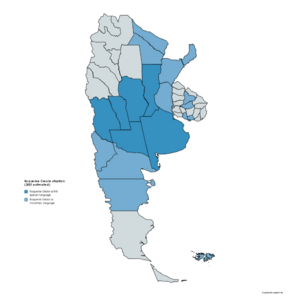Boquense Creole: Difference between revisions
No edit summary |
No edit summary |
||
| Line 18: | Line 18: | ||
| extinct = | | extinct = | ||
| era = | | era = | ||
| speakers = Around 22 | | speakers = Around 22 million people as mother language and 5 millions in the Boquense diaspora and as second language | ||
| date = 2021 | | date = 2021 | ||
| dateprefix = | | dateprefix = | ||
| Line 28: | Line 28: | ||
| familycolor = creole | | familycolor = creole | ||
| family = Romance languages-based creole | | family = Romance languages-based creole | ||
| fam1 = | | fam1 = Italic | ||
| fam2 = | | fam2 = | ||
| fam3 = <!-- up to fam15 --> | | fam3 = <!-- up to fam15 --> | ||
| Line 83: | Line 83: | ||
| mapsize = 300px | | mapsize = 300px | ||
| mapalt = | | mapalt = | ||
| mapcaption = {{colorbox|#3690c0|}} Boquense Creole as first spoken language | | mapcaption = {{ublist|item_style=white-space:nowrap; | ||
{{colorbox|#74add1|}} Boquense Creole as minoritary spoken language | |||
|{{colorbox|#3690c0|}} Boquense Creole as first spoken language | |||
|{{colorbox|#74add1|}} Boquense Creole as minoritary spoken language | |||
|}} | |||
| map2 = | | map2 = | ||
| mapalt2 = | | mapalt2 = | ||
| Line 92: | Line 96: | ||
}} | }} | ||
The '''Boquense Creole''' also known as Kriol or Criolo is an Indoeuropean languages based conlang predominantly spoken and used officially within the Republic of La Boca, mainly in the central, south and east region of the country as primary language (or mother tongue) | The '''Boquense Creole''' also known as Kriol or Criolo is an Indoeuropean-Romance languages based conlang predominantly spoken and used officially within the Republic of La Boca, mainly in the central, south and east region of the country as primary language (or mother tongue). | ||
==History== | |||
The current territory known as Republic of La Boca was firstly inhabited by Italic-origin people being many of them Genovese and Neapolitan. They wanted to create a little Italy within the then Argentinian and Uruguayan territories but failed when the President Julio Argentino Roca organized repression against them. | |||
Every try to establish a new Republic of La Boca ended in failure until 2011, when a Calabrese-Argentinian established the IV Republic of La Boca with a new flag and obviously new costumes. | |||
The population had the necessity to create a new language to make the new population distinct to the others in the rest of South America (mainly Portuguese and Spanish speakers) | |||
So, they created the ''boquense creole'' to make that difference. Many Italian, Genovese, Portuguese, Argentinian, Uruguayan, Neapolitan and then Arabic and Hebrew words were incorporated in the language both written and spoken. | |||
Revision as of 17:42, 29 April 2022
| Boquense Creole | |
|---|---|
| Boquense Kriol | |
| Criolo di La Boca | |
Native speakers | Around 22 million people as mother language and 5 millions in the Boquense diaspora and as second language (2021) |
Romance languages-based creole | |
| Language codes | |
| ISO 639-1 | boq |
| ISO 639-2 | bqc |
| ISO 639-3 | – |

| |
The Boquense Creole also known as Kriol or Criolo is an Indoeuropean-Romance languages based conlang predominantly spoken and used officially within the Republic of La Boca, mainly in the central, south and east region of the country as primary language (or mother tongue).
History
The current territory known as Republic of La Boca was firstly inhabited by Italic-origin people being many of them Genovese and Neapolitan. They wanted to create a little Italy within the then Argentinian and Uruguayan territories but failed when the President Julio Argentino Roca organized repression against them. Every try to establish a new Republic of La Boca ended in failure until 2011, when a Calabrese-Argentinian established the IV Republic of La Boca with a new flag and obviously new costumes. The population had the necessity to create a new language to make the new population distinct to the others in the rest of South America (mainly Portuguese and Spanish speakers) So, they created the boquense creole to make that difference. Many Italian, Genovese, Portuguese, Argentinian, Uruguayan, Neapolitan and then Arabic and Hebrew words were incorporated in the language both written and spoken.